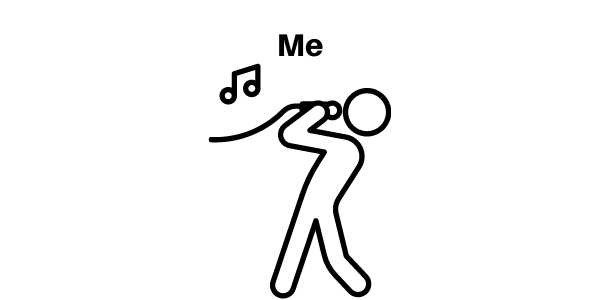Learning how to do vocal runs effortlessly is every singer’s dream.
Not only will it just impress the audience, but it just sounds too cool not to have it.
That’s why I made this guide, so that even beginner singers can learn how to develop vocal runs and impress their friends and family.
Plus, this proven system can help strengthen the voices of advanced singers who are looking to increase their vocal agility.
So let’s get started.
______
Can You Learn To Sing Runs?

If you can speak to people, then you can learn how to sing vocal runs.
Learning vocal runs is more of an advanced technique for singing, and that’s why it’s important to be pitch accurate before you attempt to do runs.
Otherwise, your voice will not sound good no matter how fast your voice is if you can’t hit every note while being pitch accurate.
But the good news is that pitch accuracy and vocal agility are skills you can develop if you put in the time and effort.
Your voice is a muscle, and just like any other muscle, it’s possible to make it flexible enough to sound amazing with enough training and time.
So What Is A Vocal Run?
A vocal run is 2 or more notes sung together in quick succession.
Typically, a run is usually 3 or more notes where singers would use them in genres like RnB, Gospel, and even Pop.
For example, here’s a run by Justin Timberlake in “Cry Me A River” below…
Although this vocal run is only downwards and in falsetto, it meets the requirements of a vocal run because:
- It hits multiple notes…
- And it’s sung together quickly.
You can add vocal runs for effect, for emotion, or just to show off your vocal prowess.
But it’s something that many famous singers use and is definitely a useful skill to learn as a singer.
So let’s get started in developing your vocal agility.
______
1. Find A Vocal Run You Want To Imitate

When I’m teaching runs for the first time, I like to use song-based training to help you learn how to do vocal runs for two reasons:
- It’s a real life example you want to learn…
- And it helps with motivation…
Although learning scales is a very effective method for learning runs, the problem with that is the exact vocal run from your favorite artist most likely does not use that exact scale for his specific run.
It’s like playing an instrument like a guitar.
You don’t learn riffs when you’re first starting by learning all the scales, but just by jumping into your favorite song and trying to replicate it.
Then you learn the scales after you have some riffs under your belt so that it becomes much easier to memorize future riffs.
And that’s exactly what you want to do with your voice.
So for now, let’s find a run that you want to imitate.
For this example, let’s go with James Arthur and the song “Can I Be Him” below…
At 0:17 he does a 3 note run in the key of B major below…

Now if you don’t know any music theory, then you have three options:
- Go to Music Notes and buy the music sheet…
- Use your ear and slow down the song to 0.25 speed find the notes…
- Have a vocal coach help you show which notes are the vocal run you want to learn…
I recommend option 1 or 3 if you are a beginner, otherwise you can go with option 2.
Knowing which notes are in the run is important because it will help develop pitch accuracy for each note.
This is because you can slow it down and make sure you hit each note perfectly before moving onto the next one.
And over time, you can start increasing the speed and make sure that you are continuing to be on pitch.
If you know which notes you have to hit, then it becomes easier to make sure your run sounds great when you increase the speed.
______
2. Learn To Stay On Pitch For Each Note

If you want to learn how to do vocal runs, then I’m pretty sure that you want them to sound great.
And the way to do that is to be pitch accurate for each note in the run.
Once you identified each note in the run, then you want to make sure that you can hit each note properly.
Rather than focusing on your agility, we want to focus on our accuracy first, even if it takes a long time to be pitch accurate.
This is because you need to be on pitch in order for a vocal run to sound amazing.
So if we continue our example with “Can I Be Him” by James Arthur, the notes we have to hit are:
- D3 Sharp.
- C3 Sharp.
- And B2 flat.
And you can use this tool and line it up with the right pitch so that it sounds good.

When you become more advanced, then you can just start using your ear to determine whether or not you are on pitch.
______
3. Drop The Speed As Low As Possible

Another way to learn how to do vocal runs and stay pitch accurate is to drop the speed as low as possible and copy singing the notes.
You can change this on Youtube with Settings → Playback Speed → 0.25.
The reason most people don’t stay on pitch is because the notes move too fast.
When we slow it down, we give ourselves enough time to find the pitch and move onto the note accurately.
It’s going to sound really weird at first… but you get used to it after a while.
Now you want to exaggerate and mouth each note like you’re Dory from Finding Nemo (Had to throw that comparison…)
And try singing along to it.
Then what you want to do is record yourself speaking slow-mo and listen to see if you are on pitch or not.
You can also use the Pitch Finder tool as well to make sure that you are hitting each note properly.
And notice the vowels that they are using.
Are they using an open vowel like “ah” or a more closed vowel like “oo.”
In our example, he’s using a more closed vowel of “oh” like Oreo.
It’s important to notice these subtleties because you are going to have to replicate it at original speed one day.
______
4. Drop The Key So That It Is Comfortable WIthin Your Voice

Now that you have dropped the speed and your being on pitch… another way to help stay pitch accurate is to lower the key so that it’s within a comfortable range in your voice.
We lowered the speed and key so that we can focus on hitting the notes correctly before we move onto the agility.
And once you can get the notes correctly, you will notice that when you change keys it’s exponentially easier to hit the right notes.
What you can use is the app Amazing Slow Downer on your phone (Apple or Android) and change the key so that it fits your voice.
When you find that key, practice it slowly before you increase the speed.
And then once you feel comfortable, start raising the key.
You will notice that the higher the key the slower your vocal agility becomes, which is perfectly natural.
It just means you haven’t developed the vocal strength yet (which is something we are training right now!)
This exercise is incredibly important because we are working on our entire range while we are learning a difficult vocal run.
______
5. Focus On Vocal Runs Downwards Before The Upward Ones

When you are focusing on learning how to do vocal runs, you want to focus on the downward runs first before the upward ones because it’s easier.
When you lower your range, what you are doing is making your voice vibrate slower and opening your throat (and relaxing) so that you can sing the lower notes.
Whereas when you try to sing a higher range, what you are doing is closing up your throat and making it vibrate faster.
That’s why it’s easier to sing the downward ones first, because relaxing your throat to hit the lower notes is just easier to do.
For example, if we do a scale run like this…

What you should focus on is the downward part of the scale before the upward ones.
When your throat becomes more used to doing the downward scales, it becomes a lot easier to do the upward ones.
______
6. Notice The Rhythm and Tempo In A Vocal Run

The best way to learn how to do vocal runs is to notice the rhythm and tempo of the run.
Now, when you first start listening to the vocal run at 100% it’s going to sound quick and you will not notice the tiny nuances (Or at least that’s with me…)
But if you slow it down enough, you are going to notice the tiny details of what the artist did with that run.
So let’s go back to the example of “Can I Be Him” by James Arthur (since by now you hopefully listened to that run…)
Slow it down to 0.25 and here’s what you will notice:
- The first two notes with the word “Stolen” are spaced equally…
- But the third note in “Sto-” is double the length before he finished with the word “stolen.”
Now, this is a very simple and important exercise to notice the tiny details that make a run sound good.
You might have even noticed it unconsciously when listening to the song and what you want to do is replicate the tempo and rhythm.
I am a firm believer in imitating, then innovating, especially when it comes with vocal runs.
When you have enough vocal runs under your belt, it becomes a lot easier for vocal runs to naturally come out of your voice with your unique tone.
And the cool part is that you can use that vocal run with that same tonality in any other song once you “own” it.
______
7. Gradually Speed Up The Vocal Run

Now once you can be pitch accurate for your vocal runs and notice the tiny details…
The next step to learn how to do vocal runs is to gradually speed it up back to its original speed.
In order to do this effectively, I recommend using Amazing Slow Downer and increasing the speed by a measly 1-2% after each loop.
So how would this work?
Let’s say I’m really struggling to do the vocal run in “Can I Be Him” with the word stolen at 100%.
So here’s what I would do to train my vocal runs for that particular riff:
- Find the song on Spotify and save it so you can open it on Amazing Slow Downer
- Open the song and drop the speed to 25% to make sure I’m pitch accurate.
- Then each time I finish the vocal run, I increase the speed to 27% and attempt the vocal run.
- I would add reps of using my lower and higher range so that my voice doesn’t get too tired.
- Let’s say I keep going and 75% is my limit. I would practice going to my limit and slightly above it (Like 85%) to slightly push my vocal agility.
- And I would do this every day.
It’s through constant repetition with the right system that will allow you to hit that vocal run cleanly.
And the reason I go above my limit is that when you go back down to your “limit” at 75% speed, for example, it’s going to sound a lot slower.
______
8. Learn To Improvise With Your Own Voice

Once you were able to get some vocal runs under your belt, the next step is to learn how to improvise them into your own songs.
a few vocal runs under your belt, then it’s time to start improvising and adding runs on your own.
The best way to learn how to do vocal runs with improvisation is to learn these three types of scales:
- Major scales
- Minor Scales
- And Harmonic Scales
You will notice that each run had a sort of pattern to it even if you don’t know which scale you used.
Plus, learning a good amount of vocal runs will help you intuitively to know whether adding a vocal run would enhance the song.
It’s especially important to learn these scales if you are planning on singing those crazy riffs that stun the audience.
Just keep experimenting and seeing what works for you.
______
How To Break Down A Complicated Run Down
The best way to learn how to break a run is to see how I do it step by step.
So let’s do a complicated run by Avery Wilson below…
Here’s how I would find out the run:
- Slow down the speed to 0.25.
- Hum the first note of the vocal run
- Find it on the piano
- Repeat steps 2 and 3 for every single note
- After enough notes, you can guess the key and figure out the later notes easier.
Here’s the first four notes I found within that run below…
And then I would keep going until I found all the notes for that song.
That’s how I would go about finding any vocal run for any song.
It takes a while depending on how good your ear is, but it’s really important for helping you recognize any vocal run you want to learn and developing your ear.
Or have your vocal teacher find the run for you.
For the advanced singers: The way to find the key is to sing a couple notes and then sing the scale up and down until you find the major 1 note.
And that’s how I would find the vocal run.
______
Famous Singers Who Use Runs
Here are some famous singers who use a lot of vocal runs in their songs:
- Ed Sheeran
- John Legend
- Ariana Grande
- Mariah Carey
- Christina Aguilera
- Justin Timberlake
______
A Quick History Of Vocal Runs

The term that is known as vocal runs would be Melisma, which is a vocal run sung on one syllable over a series of notes. Melisma has been a part of singing for 3,000 years for classical music and for famous songs like The Messiah.
Jazz and gospel singers adapted to using it to show off emotion in their songs, and then it became popularized by Whitney Houston in the 80s and 90s for pop music, and now vocal runs are used by many artists across multiple genres..
______
Frequently Asked Questions
The Difference between a riff and run?
The difference between a riff and a run is that a riff is usually some sort of a melodic succession of notes that’s recognizable (think of “Under the Bridge” by the Red Hot Chili Peppers…) whereas a run is more like an ornamental addition that calls attention to itself.
But no one would be confused if you used them interchangeably when talking to musicians, since they are super similar.
How To Do Vocal Runs On Lower Notes?
What you want to do is the same steps as above, but rather than trying to increase the key, you want to start from a higher key and slowly drop the key to the original key.
It’s going to feel weird since it’s at the bottom of your voice, but over time your voice will get used to it and the speed will increase.
How Do You Increase Vocal Agility?
The way to increase vocal agility is through systematic training and thousands of repetitions between switching notes.
You want to systematically increase the speed by 1% and focus on being pitch accurate and doing as many quality repetitions to develop the vocal agility you need for that vocal run.
Remember, I said that it was going to require patience and hard work if you truly want those crisp vocal runs.
Conclusion
This was a massive guide in learning how to do vocal runs, whether you are an advanced or beginner singer.
I went over step-by-step how to develop and strengthen your pitch accuracy and vocal agility for the riff you want to learn and the system you need to consistently follow every day.
Let me know if you have any questions below on vocal runs below…







